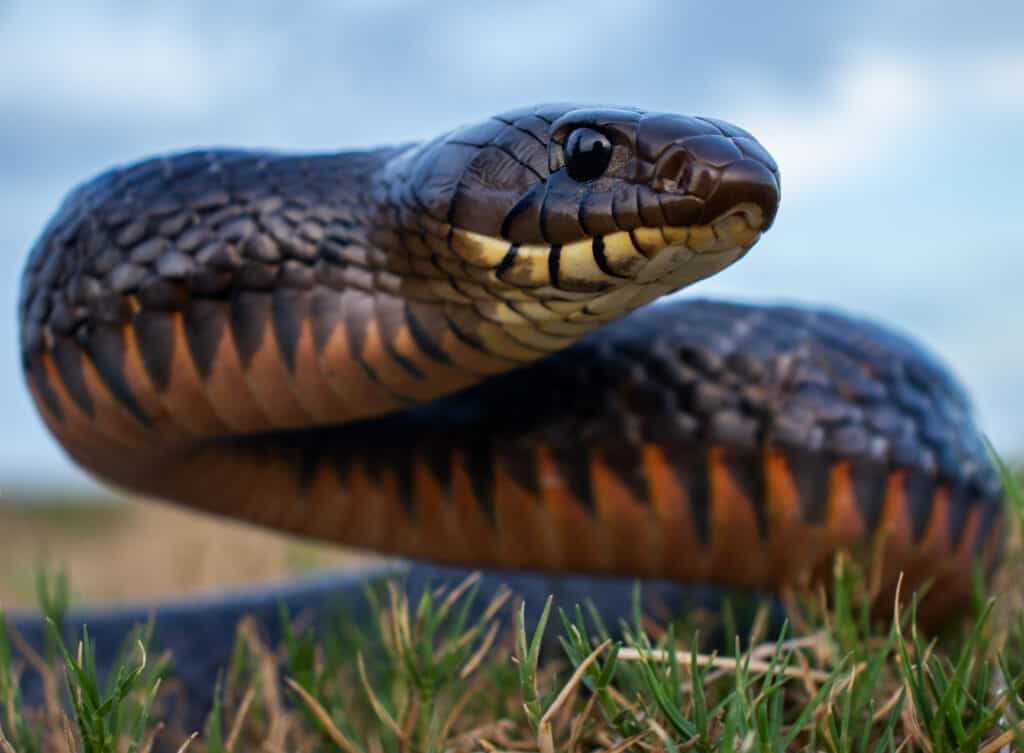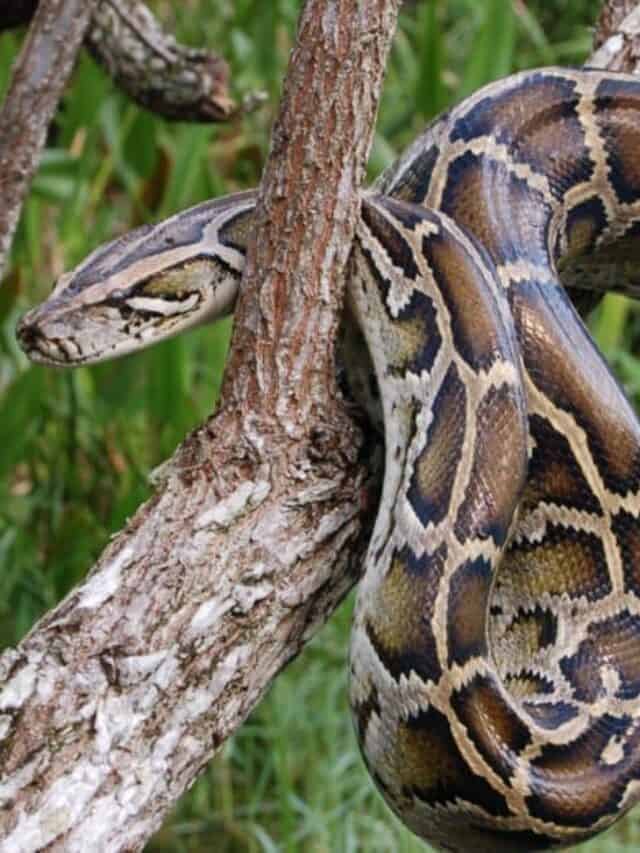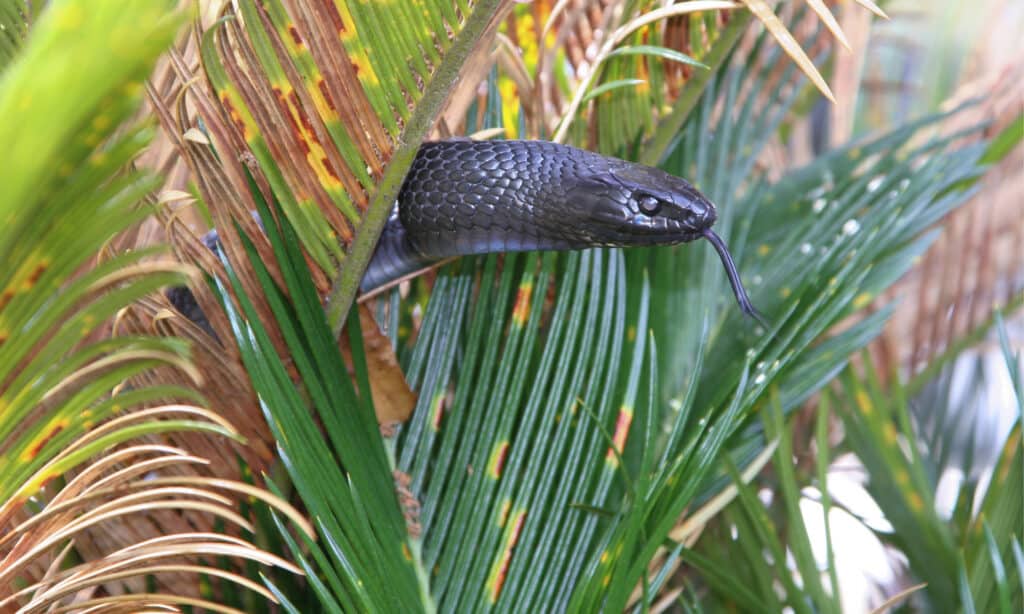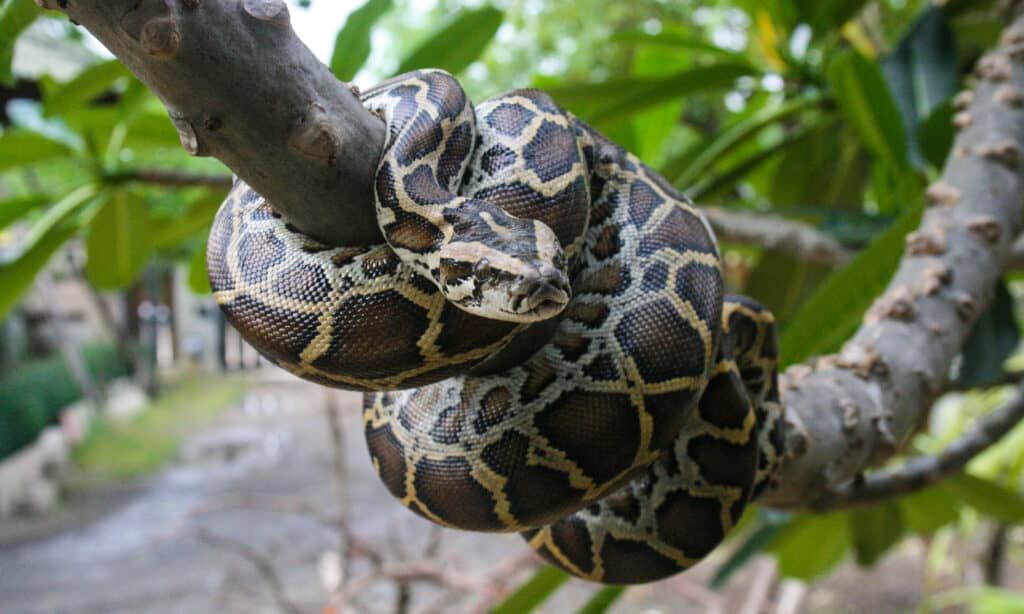Indigo snakes are long, black, and formidable hunters. They are also sometimes called the eastern indigo snake and are found in the southern and central United States.
Even though they are not venomous, they are large and fearless, and exceptionally good at hunting prey. With iridescent blue-black scales that can appear purple in some lights, they are also beautiful snakes!
This video is a striking example of one species of snake hunting another and gives us an up-close view of an indigo snake in action.

Eastern indigo snakes are the longest snakes found in the United States, reaching lengths of 5 to 7 feet, with the record length exceeding 8.5 feet.
©Radiant Reptilia/Shutterstock.com
How Could Indigos and Pythons Meet?
Burmese pythons are a native snake of Asia but are not a natural inhabitant of Florida, which is, according to the video notes and comments, where this footage was filmed. They were introduced into the area during the 1970s and 1980s as part of the exotic pet trade.
Many would-be snake owners found that they could not cope with these large animals and released them into the wild whilst others escaped. They began to breed and establish a population of their own which has had consequences for native species.
However, here we see one of those native species getting its own back on the python in a spectacular way! The python is a large snake and can grow over 20 feet long. This one is a baby python and may have tried to move away from the nest before predators could pick up the scent. Unfortunately for this little python, it is already too late because they have been detected by an indigo snake.
Pythons are also hunted by humans and alligators; in turn, they hunt their own prey by grasping them with sharp teeth and then coiling around the animals and squeezing them until they suffocate. We see the small python attempting that tactic on the larger snake as a form of defense but without success.

The indigo snake is best known for its blue-black scales.
©Patrick K. Campbell/Shutterstock.com
Indigo Snake Hunting a Python
The attack starts when the indigo snake picks up the scent of its prey. They follow behind for a short time, carefully maneuvering themselves into a good position to strike, which they do to great effect. They grasp the python just behind their head, which secures it and partially blocks the airway.

Due to their large size,
Burmese
pythons have few predators.
©Heiko Kiera/Shutterstock.com
The tactic is to pin the python to the ground until they are exhausted. It stays in this position until the younger snake tires and stops struggling so much. Then they drag their prey back to their den whilst swallowing their prey alive and whole.
At the end of the video, we see the last part of the python’s tail disappear into the indigo’s mouth. Job done!
Are Indigo Snakes Normally Cannibalistic?

Texas indigo snakes are large active snakes that flush out prey and then overpower it.
©iStock.com/sstaton
Indigo snakes are not normally cannibalistic. They are non-venomous constrictor snakes that typically feed on a variety of prey, including rodents, birds, lizards, and other snakes. While there have been rare cases of indigo snakes preying on smaller individuals of their own species, cannibalism is not a common behavior for this species.
Some of the snakes they may consume include rat snakes, copperheads, and even venomous species such as rattlesnakes and cottonmouths. However, their diet mainly consists of small mammals and birds, and they are considered to be important predators in many ecosystems.
What Do Indigo Snakes Normally Eat?
Well, not pythons, that’s for sure. Indigo snakes and pythons do not live in the same geographical area. Pythons don’t make up part of an Indigo snake’s natural diet. However, they do eat snakes!
Eastern indigo snakes are some of the most impressive predators in North America. Growing up to 8 feet long, they have a beautiful bluish-black color with glossy scales and a wide head. These terrestrial predators spend most of their time searching for prey on land, such as small mammals like mice and rabbits, birds, frogs, turtles, and turtle eggs.
In addition to these animals, Eastern indigo snakes will also feed on other snakes – even venomous species like cottonmouths and rattlesnakes! They hunt by quickly exposing and chasing down their prey before capturing it in their powerful jaws.
Despite being apex predators themselves, Eastern indigo snakes play an important role in the ecosystems they inhabit by controlling rodent populations which can help reduce disease transmission rates among humans living nearby.

The Eastern indigo snake can grow over nine feet in length, which makes it daunting.
©iStock.com/sstaton
Burmese Python vs Indigo Snake: Who Would Win in a Fight?
Burmese pythons and indigo snakes are two large snake species. The Burmese python is native to Southeast Asia, while the indigo snake can be found throughout much of the southeastern United States.
These two animals have vastly different sizes, with the Burmese python reaching lengths up to 26 feet long while the indigo snake typically maxes out at 8 feet long. Neither snake is venomous, but they do possess sharp teeth that they use to catch prey.

Burmese pythons are among the largest snakes on Earth.
©iStock.com/Lunatic_67
Due to their massive size difference, it’s clear that a Burmese python would win in a fight against an indigo snake. While both snakes have powerful jaws and sharp teeth, these features are amplified in the larger Burmese python due to its bigger head and more developed musculature.
Additionally, its longer body gives it greater reach when striking out at opponents, which further increases its chances of success against smaller adversaries like an indigo snake.
The photo featured at the top of this post is © Radiant Reptilia/Shutterstock.com
Discover the "Monster" Snake 5X Bigger than an Anaconda
Every day A-Z Animals sends out some of the most incredible facts in the world from our free newsletter. Want to discover the 10 most beautiful snakes in the world, a "snake island" where you're never more than 3 feet from danger, or a "monster" snake 5X larger than an anaconda? Then sign up right now and you'll start receiving our daily newsletter absolutely free.
Thank you for reading! Have some feedback for us? Contact the AZ Animals editorial team.






